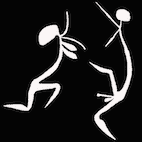Yawkyawk (Ngalkunburriyaymi): The Spirit Mermaids of Arnhem Land
Language Group: Kunwinjku
Moiety: Yirridjdja
Associated Clans: Djalama, and others across Western Arnhem Land
Region: West Arnhem Land, Northern Territory, Australia
Primary Themes: Water, fertility, ancestral spirits, freshwater ecology,
Ancestral Beings of the Freshwater Dreaming
In the sacred pantheon of Western Arnhem Land, few figures are as revered or visually arresting as the Yawkyawk—spirit beings whose presence haunts the deep freshwater waterholes of the stone country. Known by their traditional name Ngalkunburriyaymi in the Kunwinjku language, these freshwater mermaid spirits embody the mystery of life’s origins, the vitality of water, and the generative power of the land itself.
Half-human, half-fish, Yawkyawk are feminine ancestral spirits often depicted with flowing hair made from Lillies or waterweed and the sinuous tails of aquatic creatures. They are guardians of water sources and totemic icons of fertility, both human and ecological. These dieties are shapeshifters and can appear as frogs or even the waterhole itself with only the Lilly hair appearing above the waters surface. Their Dreaming stories are intertwined with the Rainbow serpent Wagilag sisters and depiction vary by clan a but share common themes of transformation Moral law, and creation.
The Story of the Wagilag sisters ends when they are killed and consumed by the Rainbow serpent but their spirit being are still still present and in Western Arnhem Land and in this spiritual form they are Yawkyawk.
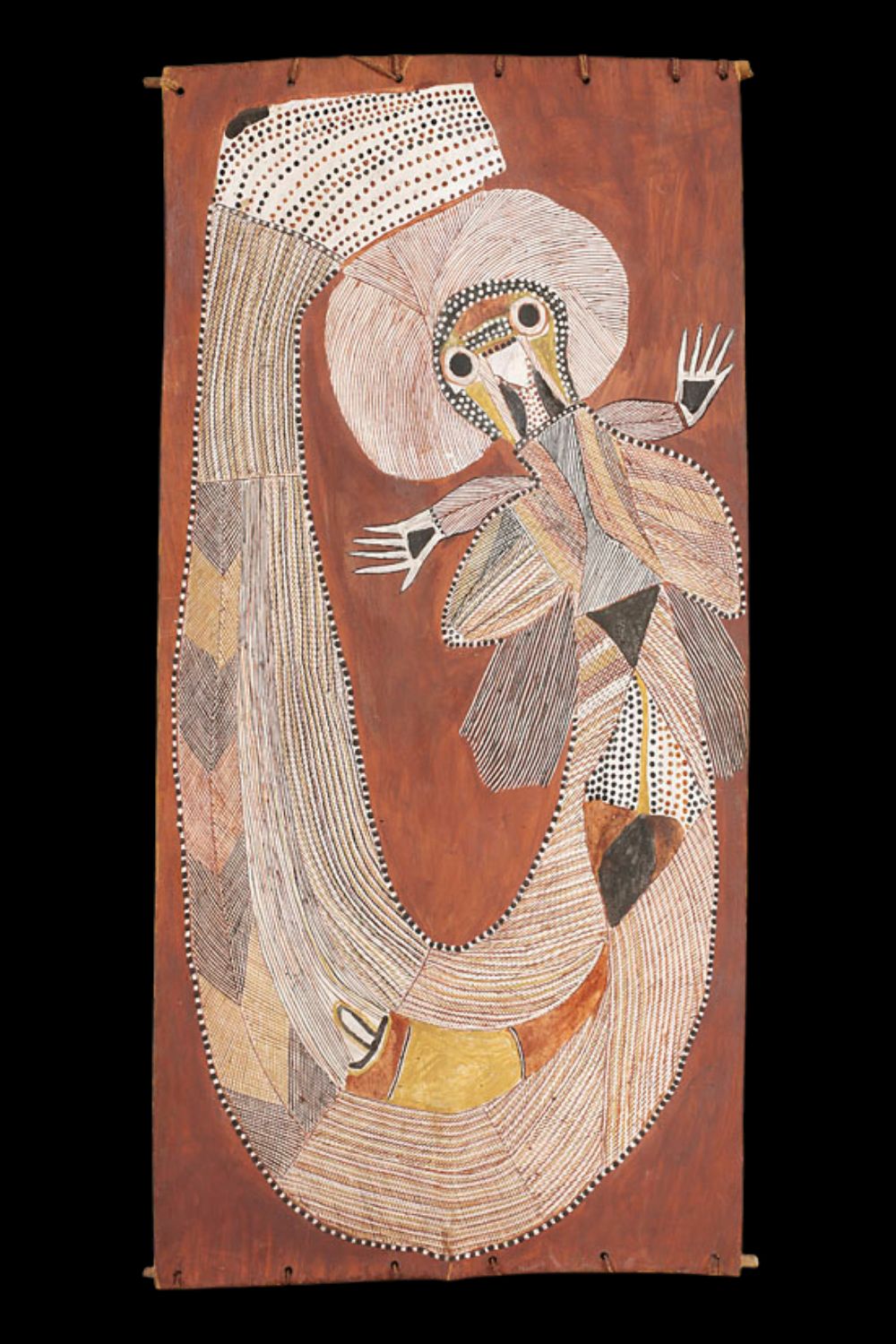
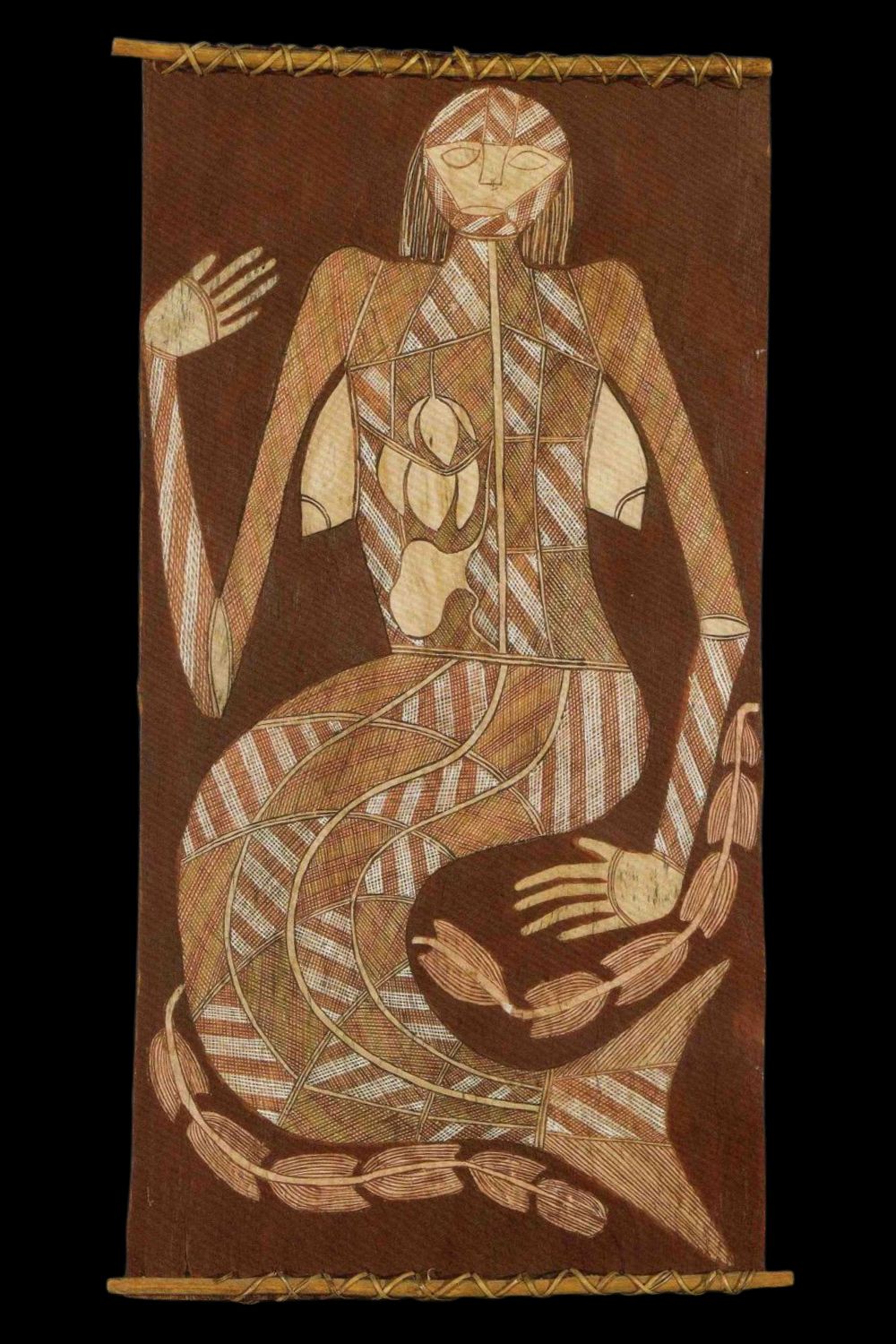
Cultural Authority and the Right to Depict
In Aboriginal art, to paint a Yawkyawk is not merely a matter of creative expression—it is an act of cultural responsibility. Only those with inherited rights through moiety, kinship, clan, and Dreaming affiliation are permitted to depict these ancestral spirits. Among the Yirridjdja moiety, particularly in the Djalama clan whose estate lies between the Goomadeer and Liverpool Rivers, the Yawkyawk are foundational Dreaming figures.
These laws of depiction protect sacred knowledge and reinforce the authority of senior lawmen and artists. For this reason, paintings of Yawkyawk figurest extends beyond aesthetics.
Iconography and Stylistic Expression
The Yawkyawk / Wagilag sisters are intimately intertwined with the rainbow serpent and this relationship lends itself to painterly innovation. Artists depict different stages and aspects of the dreaming and use symbolic motifs to convey the fluidity and shape shifting nature of these freshwater hole spirits.
In some paintings the Yawkyawk spirits are nothing more than faces in the coils of the Rainbow serpent where in others they are depicted as frogs or half human half fish or in their human form.
The variety of their depictions are so vast and this story so central to Arnhemland dreaming that these encoded images are often lost on people who are not aware of the story of the wagilag sisters.
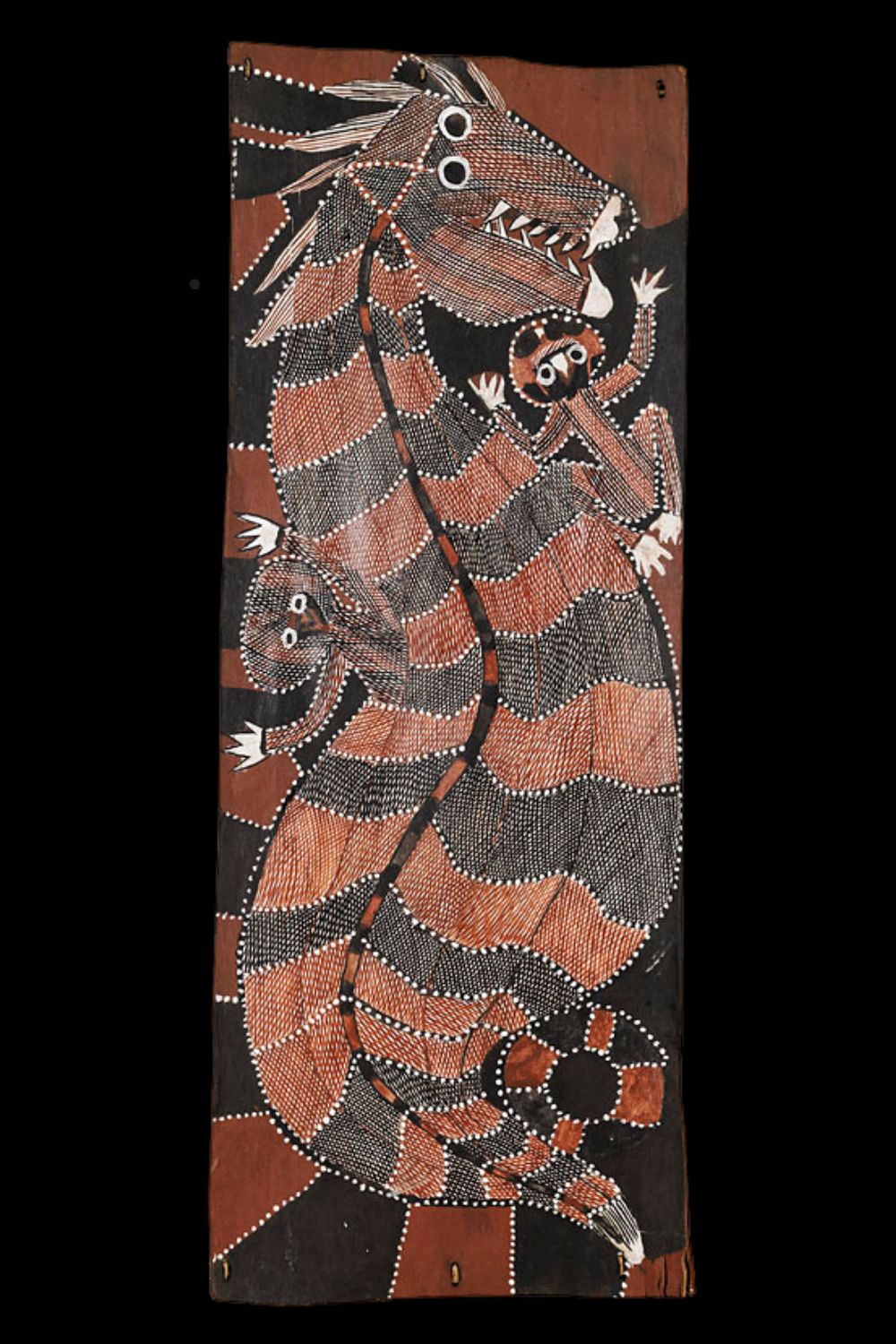
Painters of the Yawkyawk
Several of Arnhem Land’s most celebrated bark painters have inherited the cultural authority to depict Yawkyawk.
Yawkyawk in Rock Art – Oenpelli’s Ancient Depictions
The precise antiquity of Yawkyawk imagery in Arnhem Land is unknown, yet the Kunwinjku people of Oenpelli (Gunbalanya) have been painting the interconnected stories of the Rainbow Serpent, the Wagilag Sisters, and the Dreaming events that gave rise to Yawkyawk for countless generations. Archaeological evidence shows that Oenpelli X-ray rock art—a distinctive style characterised by finely detailed internal anatomy—dates back at least 11,000 years, making it among the oldest continuous artistic traditions on earth.
Within this tradition, the depiction of beings that are half woman, half serpent occupies a powerful ceremonial role. Such paintings were created not merely as decoration but as vital teaching tools within initiation contexts, enabling young initiates to visualise the hybrid form of this transformative ancestral being. The merging of human and serpentine features conveys both the beauty and the danger inherent in Yawkyawk cosmology—linking them to the life-giving waters they guard and the spiritual authority they command.
These ancient rock images serve as the visual ancestors of contemporary Yawkyawk art, influencing generations of bark painters and sculptors. They stand as enduring records of the deep time continuity between past and present, preserving the sacred narratives that remain central to Kunwinjku cultural identity.
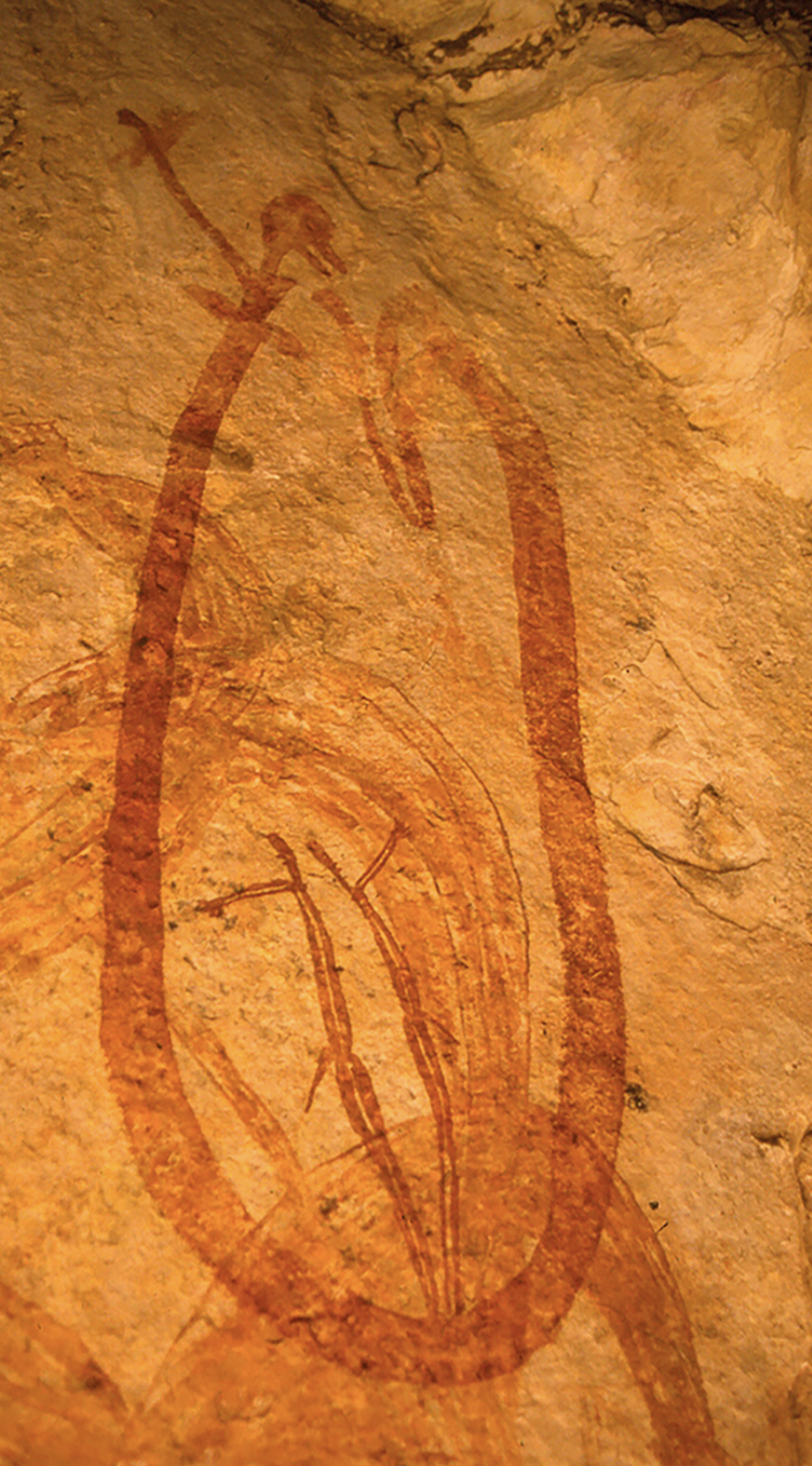
Mick Kubarrku – Yawkyawk
While the celebrated Kuninjku artist Mick Kubarrku (1925–2008) is best known for his iconic renderings of Pandanus spirits, his oeuvre also includes rare and striking portrayals of Yawkyawk—the freshwater mermaid spirits of Western Arnhem Land. In these works, Kubarrku embraces the classic mermaid-like imagery most widely associated with Yawkyawk: the upper body of a woman seamlessly merging into the shimmering, scaled tail of a fish.
Kubarrku’s depictions, executed in natural earth pigments on eucalyptus bark, convey not only their physical beauty but also their deep spiritual significance. He depicts Yawkyawk with a triangular face as he does with his other depictions of spirits.
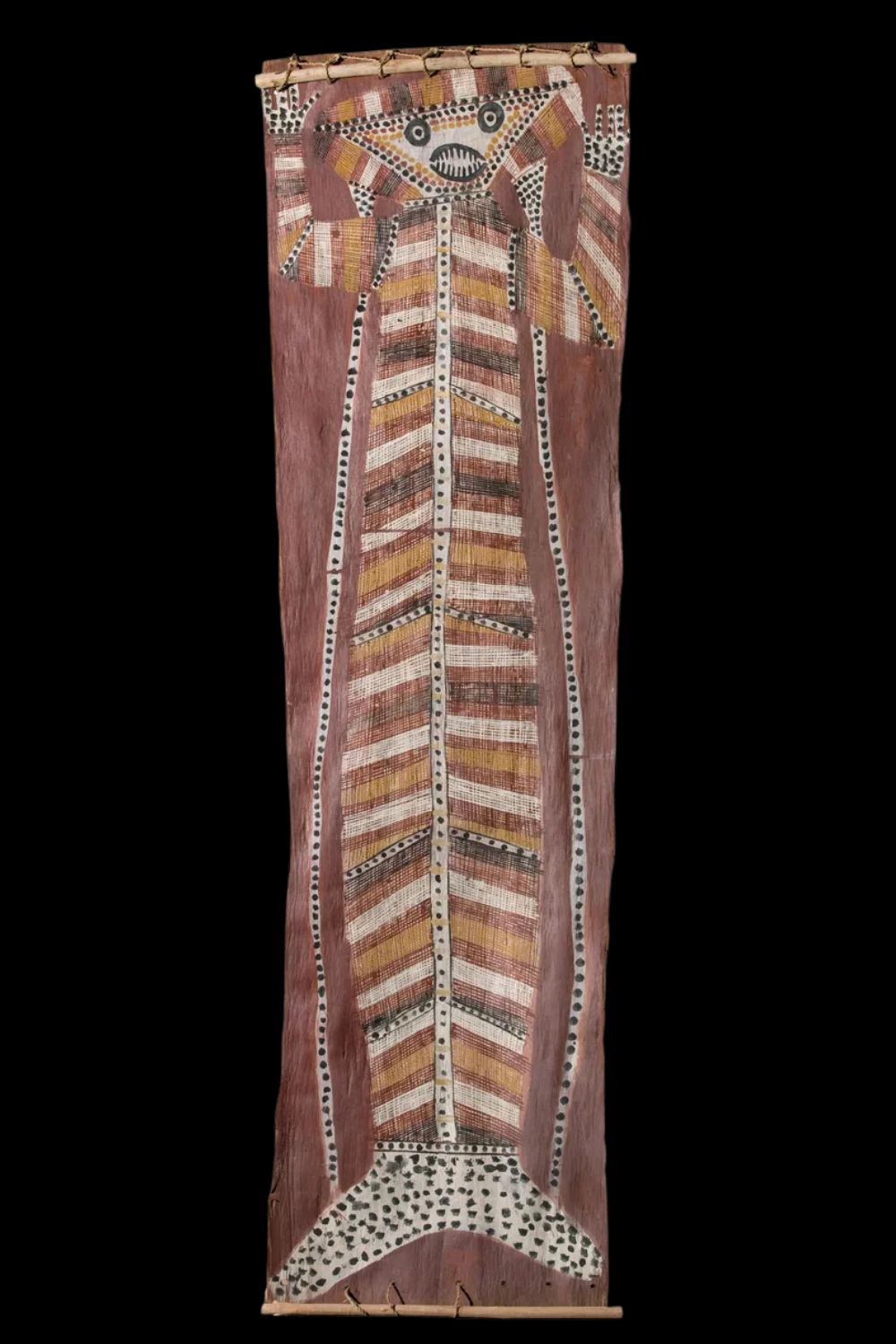
Bobby Ngainjmirra – Yawkyawk
The distinguished Kunwinjku artist Bobby Ngainjmirra (c.1941–2020) is known for his refined bark paintings of Yawkyawk, the freshwater mermaid spirits who inhabit the sacred waterholes of Western Arnhem Land. As the recognised custodian of this Dreaming within his clan, Ngainjmirra held the cultural authority to depict these powerful ancestral beings, and his works embody both the ceremonial depth and artistic mastery that such responsibility entails.
Ngainjmirra’s Yawkyawk paintings range from highly traditional renditions to later examples that, while retaining their spiritual foundation, display subtle anglicised elements intended to meet the growing demand of the commercial art market. These adaptations—such as adjustments to compositional balance, figure proportion, or decorative emphasis—reflect a broader moment in the history of Aboriginal art, where artists navigated the space between cultural fidelity and market appeal.
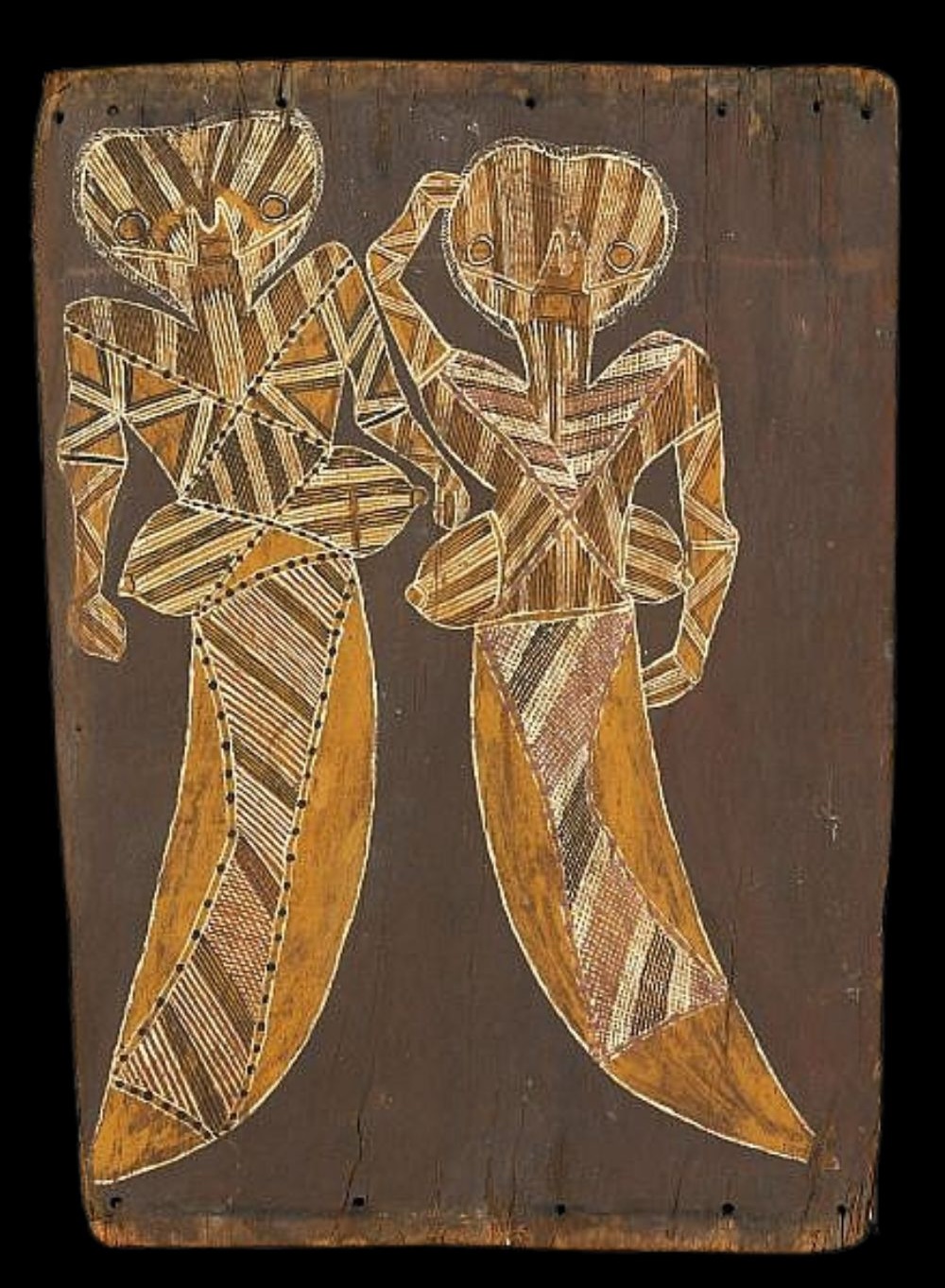
Dick Murramurra Ngueli Ngueli – Yawkyawk
Although Dick Murramurra Nguelingueli (c.1920s–1994) possessed the traditional ceremonial right to depict Yawkyawk, these enigmatic freshwater mermaid spirits of Arnhem Land appear only rarely in his oeuvre. When he did turn his hand to the subject, his interpretations were distinguished by a singular and culturally significant detail: within the flowing fish tail of the Yawkyawk, he rendered the legs and feet of the spirit being.
This visual device is far from a stylistic whim. It symbolises the transformative nature of the Yawk yawk, beings who can appear in multiple forms—sometimes as fully human women, sometimes as fish-tailed water spirits, and at other times as entirely different creatures. For the Kuninjku and neighbouring language groups, this ability to shift between realms is at the heart of Yawkyawk cosmology, reflecting themes of metamorphosis, spiritual power, and the fluid boundary between the physical and ancestral worlds.
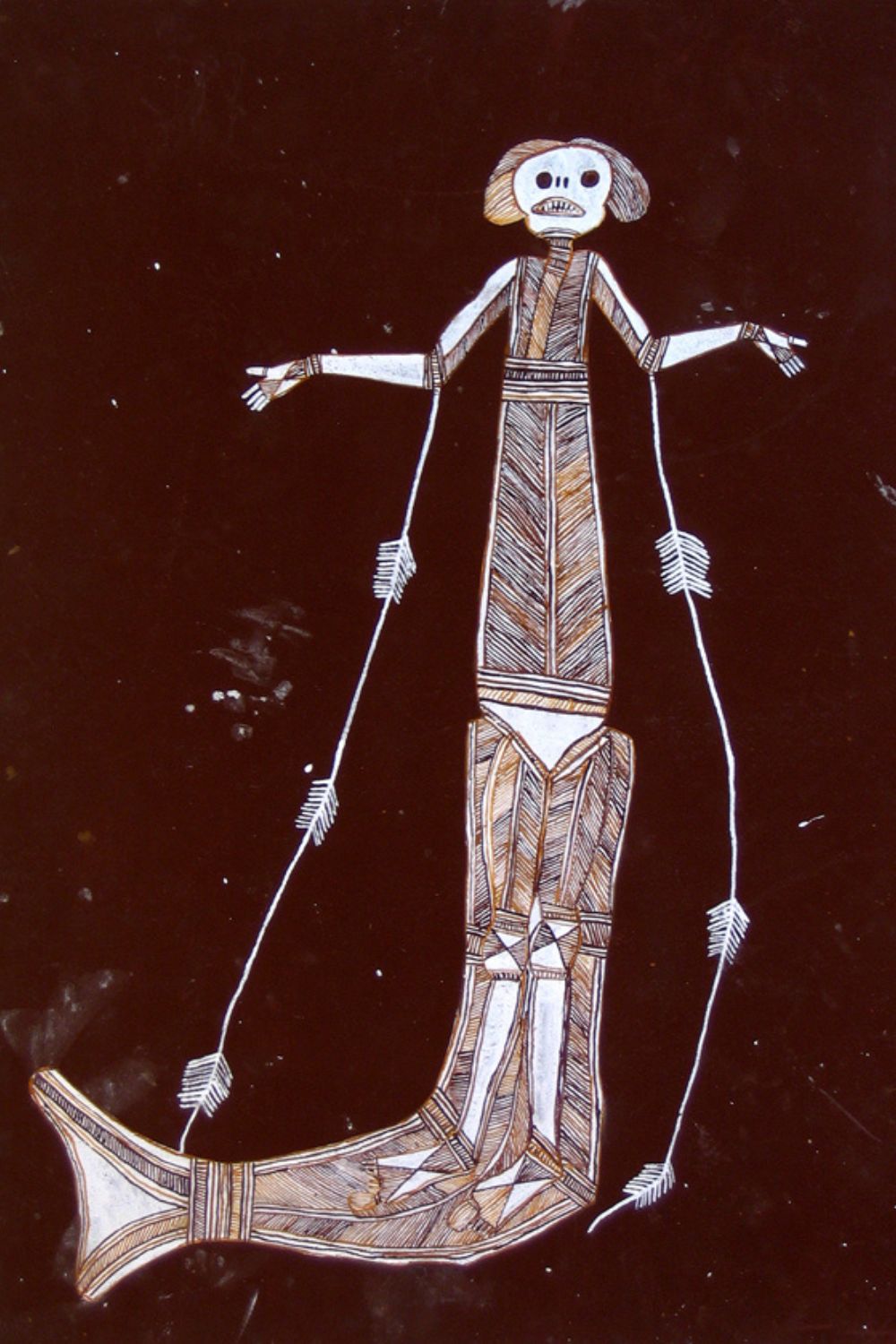
Yawkyawk Sculpture
In addition to their celebrated presence in bark painting, Yawkyawk—the freshwater mermaid spirits of Arnhem Land—have also been powerfully realised in three-dimensional form through contemporary Aboriginal sculpture. Several leading female artists, including Anniebell Marngamarrna, Marina Murdilinga, Lulu Laradjbi, and Dorothy Bunibuni, have transformed natural and found materials into mesmerising sculptural visions of these ancestral beings.
These works are typically created using cane armatures wrapped and interlaced with woven fishing nets, a technique that allows the artists to evoke the fluidity and sinuous grace of the Yawk yawk’s fish-tailed form. The translucent quality of the netting, combined with painted or dyed surfaces, creates a sense of shimmering movement—recalling the way light dances across the surface of a sacred waterhole.
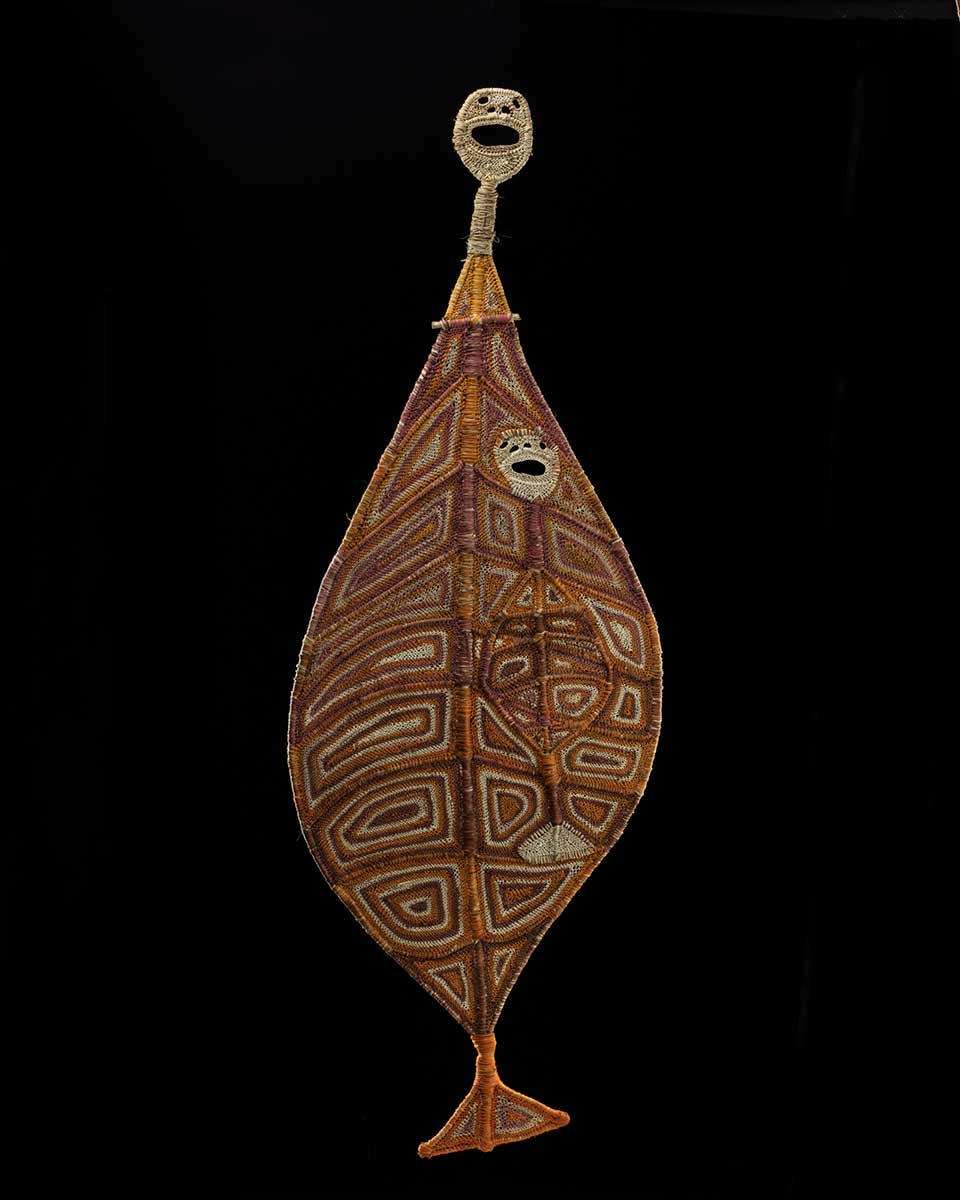
Curly Bardkadubbu – Yawkyawk
The celebrated Arnhem Land artist Curly Bardkadubbu is recognised for his innovative and varied interpretations of Yawkyawk, the freshwater mermaid spirits whose presence in Kuninjku cosmology is both beautiful and enigmatic. While many bark painters adhere to the widely known form—half woman, half fish—Bardkadubbu extended this visual language to include extraordinary depictions of Yawkyawk spirits with the face of a woman and the sinuous body of the Rainbow Serpent.
This striking variation speaks directly to the transformative essence of the Yawk yawk. In Aboriginal tradition, these beings are not confined to a single form; they can shift between identities, blending human, aquatic, and serpentine features. Bardkadubbu’s works capture this fluidity with a mastery of composition and ochre application, using intricate rarrk (cross-hatching) to suggest movement, power, and the spiritual energy that flows between waterholes, rivers, and the ancestral realm.
By integrating the Rainbow Serpent, one of the most revered creation beings in Arnhem Land, Bardkadubbu reinforces the interconnectedness of water spirits, fertility, and the cycles of life. His Yawkyawk paintings are therefore not only visually arresting but also layered with ceremonial significance, offering viewers a deeper insight into the complexity of Aboriginal spiritual iconography.
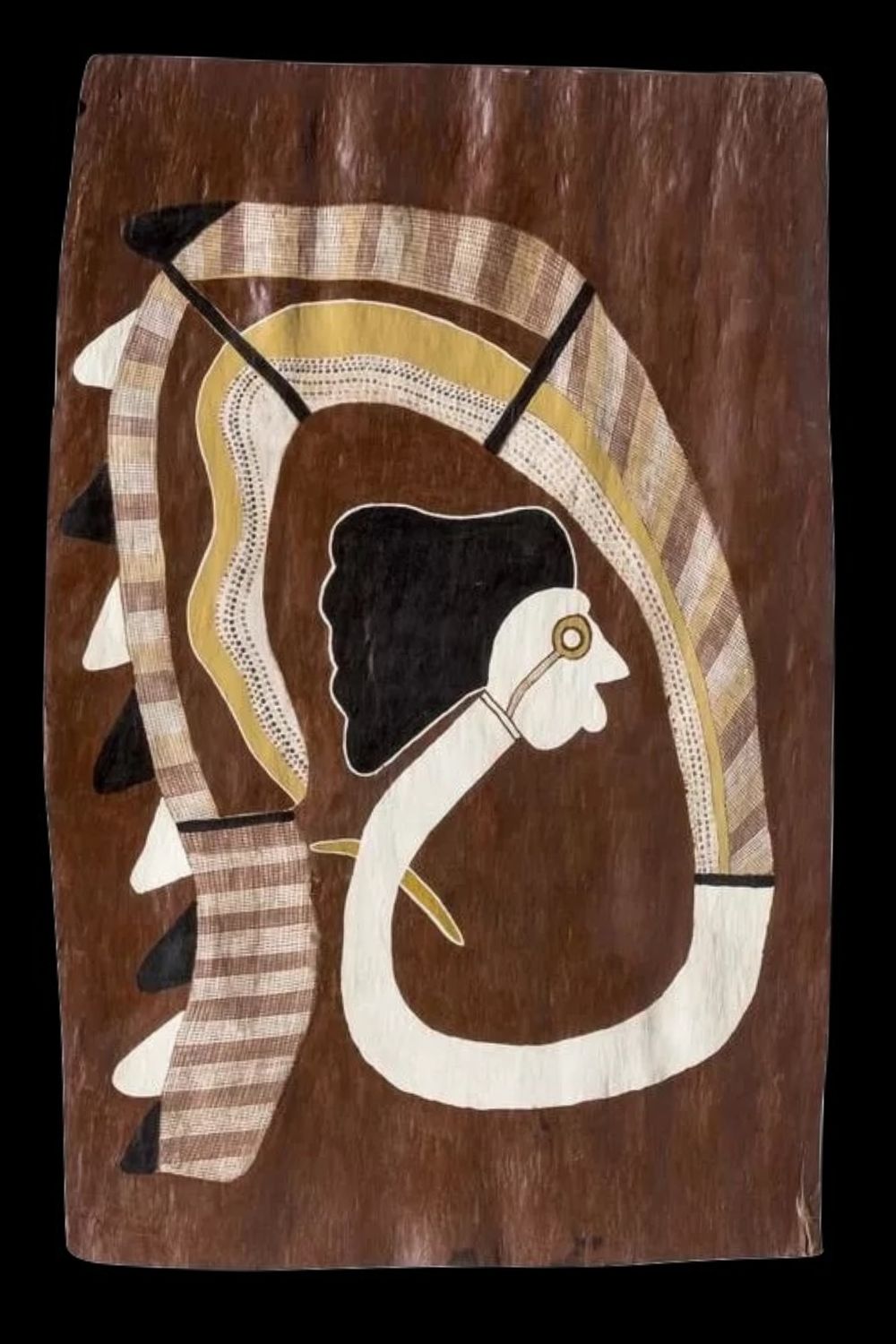
Owen Yalandja – Yawkyawk Sculptures
Kuninjku master sculptor Owen Yalandja is custodian of the Yawk yawk spirits linked to the Yirridjdja moiety djang of Mirrayar billabong in his Dangkorlo clan estate.
Yalandja learned carving from his father, Crusoe Kuningbal, a celebrated singer and sculptor renowned for mimih spirit figures. Kuningbal pioneered the dotted wooden mimih sculptures used in Kuninjku ceremonies, later applying similar techniques to bark paintings of Yawkyawk. His work often depicted these spirits with dotted bodies, symbolising their creative essence at sacred waterholes such as Barrihidjowkeng. Before his death in 1984, Kuningbal encouraged his wife, Lena Kurinya, and sons to continue carving.
In the 1990s, Yalandja shifted his focus to Yawkyawk figures, refining his father’s dotting style into intricate scale-like patterns—delicate arcs evolving into fine V-shapes, chevrons, and alternating triangles. He broke from tradition by favouring black-and-white palettes over ochre grounds and by choosing the durable kurrajong tree for carving, allowing for graceful three-dimensional forms. His figures often feature elegant bifurcated bodies and fishtails poised on triangular tips, evoking movement through water.
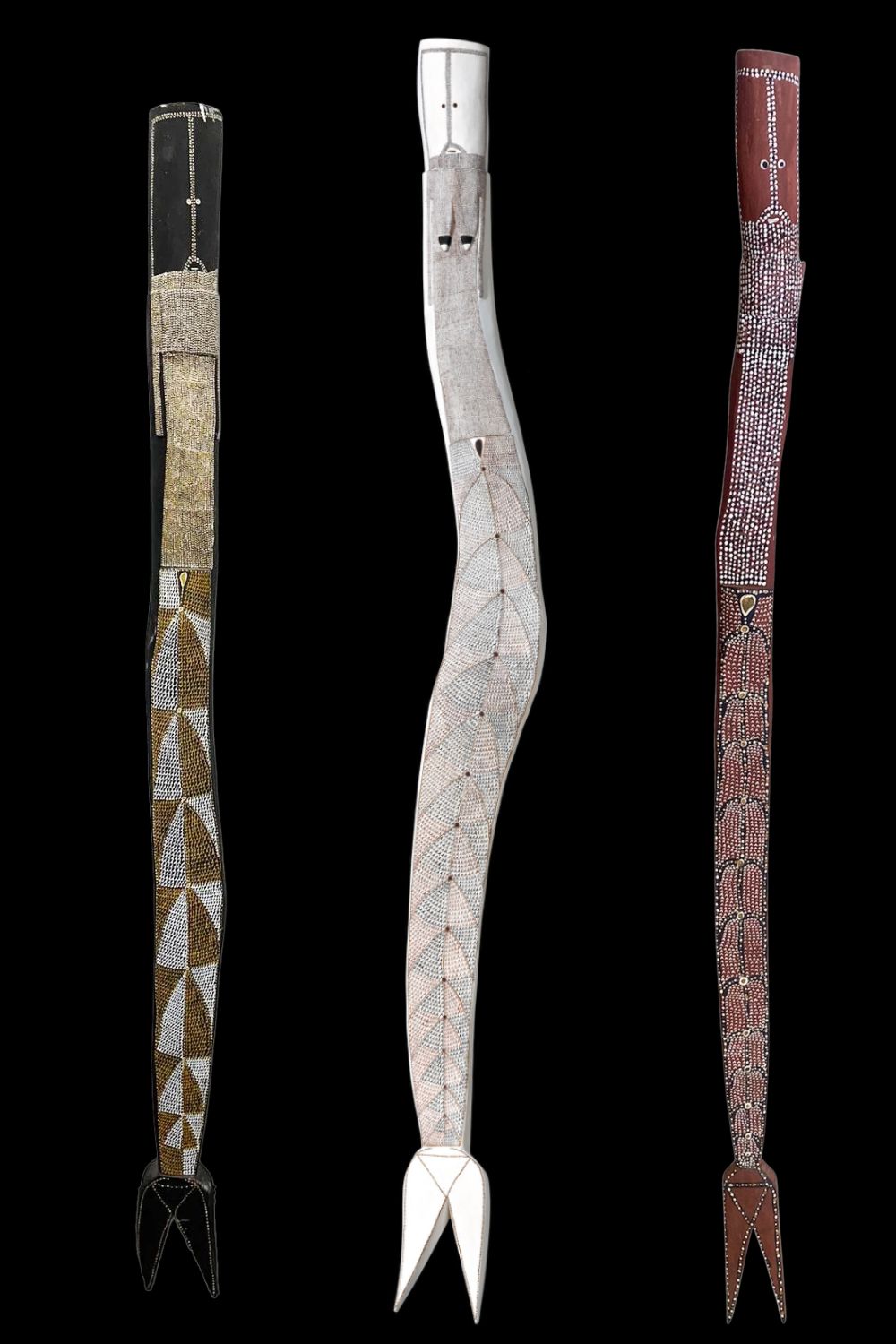
Peter Marralwanga – Yawkyawk and the Rainbow Serpent
Renowned Kuninjku artist Peter Marralwanga (1916–1987) brought to life some of the most compelling visual interpretations of Yawkyawk, the freshwater mermaid spirits of Western Arnhem Land. While many Aboriginal bark painters portray Yawkyawk as graceful women with fish tails, Marralwanga’s work is distinguished by its narrative complexity and cultural depth. His paintings sometimes depict the Yawkyawk sisters in their human form, or transformed into frogs, alongside the formidable Rainbow Serpent—one of the most powerful ancestral beings in Aboriginal cosmology.
In Marralwanga’s telling, the Yawkyawk sisters are not merely companions to the Rainbow Serpent; they are ultimately consumed by it, becoming an inseparable part of its spiritual essence. This union is analogous—within its own sacred context—to the Christian belief in the unity of Jesus and God: distinct yet one, joined in eternal presence.
The artist’s fine rarrk (cross-hatching) and mastery of ochre pigments imbue these works with both ceremonial authority and aesthetic vitality. Each painting serves as a visual archive of Arnhem Land’s Yawkyawk mythology, bridging rock art traditions with contemporary bark painting practice.
Through his art, Marralwanga reaffirms the Yawkyawk’s place as guardians of waterholes, embodiment of fertility, and participants in creation narratives that remain central to Kuninjku culture today.

Yirawala – The Wagilag Sisters and the Origins of Yawk yawk
The legendary Western Arnhem Land artist Yirawala (c.1897–1976), often hailed as one of the most influential figures in Aboriginal bark painting, is not known to have painted Yawkyawk directly. However, his celebrated works depicting the Wagilag Sisters and their dramatic encounter with the Rainbow Serpent are deeply connected to the spiritual origins of the Yawkyawk.
In Kuninjku and neighbouring traditions, the Wagilag Sisters’ epic journey and eventual death at the hands of the Rainbow Serpent is an origin story for many water-based ancestral beings, including the Yawkyawk. These narratives establish the deep spiritual connection between sacred waterholes, fertility, and transformation—central themes in Yawkyawk cosmology.
g
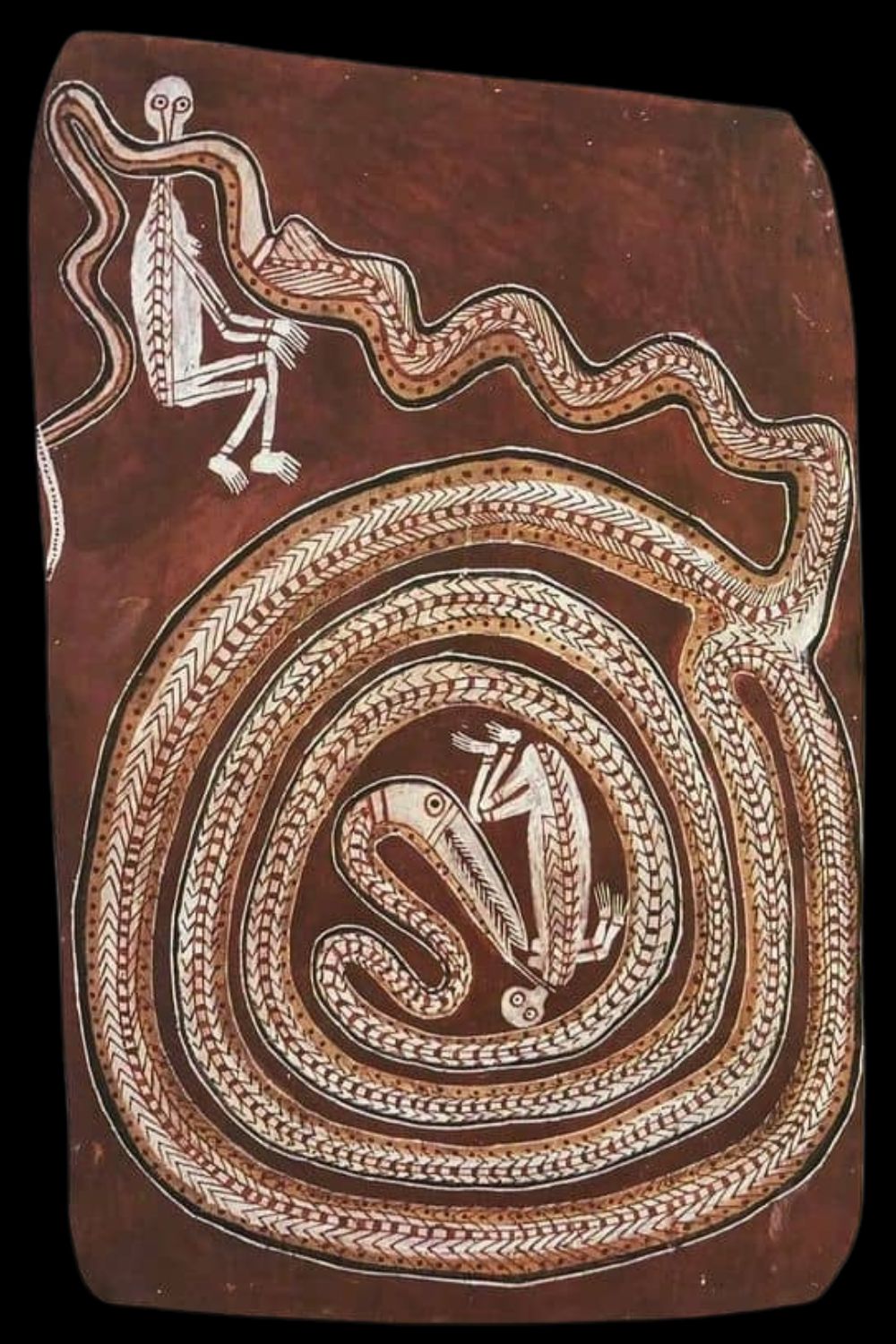
All images in this article are for educational purposes only.
This site may contain copyrighted material the use of which was not specified by the copyright owner.
